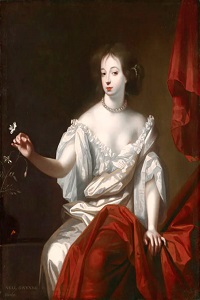How will these resources help you?
All too often, the great deeds of women are overlooked or overshadowed by those of men. This was true even for women who wielded political power and exerted influence at court, including that of Charles II. Charles's many mistresses and his wife, Catherine of Braganza, played significant political, cultural, and social roles. The resources given here aim to enable students to focus on these roles, to encourage discussions around ‘soft power’ and how these women used their wits in order to achieve their ambitions. The reasons they remained in favour were more complex than mere physical attraction: companionship, and even friendship, with the king was essential if they were to climb the ladder of courtiers. These resources will enable teachers to create engaging sessions, considering questions such as: ‘How did women shape Charles II’s court?’, ‘How did they influence his politics?’ and ‘What roles did they play in the cultural life of seventeenth-century Britain?’
An overview

Mistresses: Sex and Scandal at the Court of Charles II
by Linda Porter, published by Picador, (2021), 9781509877072
This book is the perfect starting point from which to engage with both the well-known and the lesser-known women who influenced Charles II. Each part deals with one of Charles’s lovers, including his wife. From the actress Nell Gwynn, to the ambitious duchess Barbara Villiers, to the double-agent Louise Kérouaille and the non-conformist Hortense Mancini, this book tells the incredible stories of their formidable lives. These women – though all linked through the king – had their own dreams, ambitions and desires. The book helps show how these women marked history in their own right.
The royal couple

Charles II and Catherine of Braganza: A loveless marriage?
published by The History Press, (2023)
This article is central to our understanding of the royal couple, Charles and Catherine of Braganza. While Catherine has been overlooked due to her husband’s many mistresses, the question of love is raised here. With the restoration of his throne, Charles dutifully married with the aim of bringing peace and prosperity to his realm. This resource will help students to discuss the dynamics between royal couples as well as the purpose of dynastic alliances in a broader context, enabling discussions around duty and love, as well as why women are mostly overlooked in history.

From the Slums of London to the Kings Court: The Story of Nell Gwynn
by Megan Crutchley, published by Retrospect Journal, (2022)
Very well argued and researched (with a short bibliography at the end) this source offers a glimpse of the most famous mistress at Charles II’s court. It starts with Nell Gwynn’s talents and skills as an actress and the growing importance of theatres in the Stuart culture. From a humble background and despite all the odds, Nell Gwynn eventually became Charles II’s mistress. This article reveals the story of a woman with great wit and intelligence who seduced the king and gave him two sons (one died in infancy but the other one survived and was given the title of Duke of St Albans). Combined with the other sources, this article puts Nell Gwynn at the centre of politics and shows that women who were mistresses could also be political players.
Further materials
Catherine of Braganza, the neglected Queen by Linda Porter, published by Historia, (2021)
Read this article
Nell Gwynn: the orange girl who became a king's mistress in Restoration England, published by History Extra, (2021)
Read this article
Catherine of Braganza: the lost Stuart queen by Eilish Gregory, published by ArtUK, (2019)
Read this article
Dr Estelle Paranque is Assistant Professor in Early Modern History at Northeastern University London. She has published extensively on Elizabeth I of England, Catherine de Medici, the French kings and queen consorts and Anglo–French diplomatic relations. She is the author of Elizabeth I of England Through Valois Eyes: Power, Diplomacy and Representations in the Reign of the Queen, 1558–1588 (2019) and Blood, Fire, and Gold: Elizabeth I of England and her French Rival Catherine de Medici (2022).
Text © Dr Estelle Paranque, 2023.
Text © Dr Estelle Paranque, 2023.



